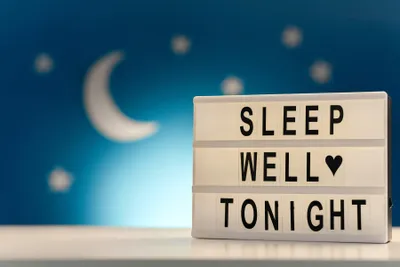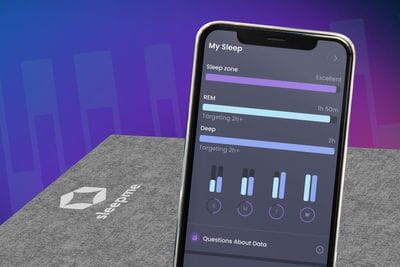
Relaxation is essential to falling asleep quickly, as it prepares the body and mind for sleep. Various activities, including meditation, breathing exercises, and guided imagery, can promote sleep.
Experiencing difficulty falling asleep is a common challenge for many individuals. If you've encountered this issue, you're not alone. A recent study found approximately 30% of adults experience difficulty falling asleep occasionally. [1]
Not being able to sleep is frustrating. It can also make it harder to sleep in the future. This is because it affects your sleep latency.
But with the right techniques and strategies, you can learn to fall asleep faster. Follow these methods for better sleep, but remember that everyone's sleep patterns are different.
Unleash Cool Comfort
Bid farewell to night sweats! Enhance your sleep quality with our Chilipad Dock Pro and Chilipad Cube sleep systems to avoid night sweats caused by overheating.
How Long Does it Take to Fall Asleep?
Sleep latency, also known as sleep onset latency, refers to how long it requires someone to fall asleep. Generally, a healthy sleep latency period ranges between 15 to 20 minutes. [2] This time frame excludes pre-sleep bedtime routines such as taking a shower, brushing teeth, or practicing meditation but pertains to falling asleep after getting into bed.
Tips to Help You Sleep Faster
Below, we will discuss some of the best tips to help you get to sleep quickly. From relaxation techniques to lifestyle changes, these strategies will help you drift off into dreamland faster than ever before.
4-7-8 Breathing Exercises
Dr. Andrew Well developed the 4-7-8 breathing method, a simple breathing technique that can help you relax and fall asleep faster. It's based on breath control techniques from yoga and has a consistent breathing pattern that calms the nervous system.
It involves inhaling for 4 seconds, holding your breath for 7 seconds, and exhaling for 8 seconds. Doing so allows your breathing and heart rate to slow down, and helps relieve stress and anxiety to help you fall asleep quickly.
You can perform this exercise anywhere, anytime, whenever you need a moment of calm.
Read More: The Benefits of Deep Breathing Exercises
Military Method
Also known as the "SEALs sleep trick," The Military sleep method is a technique designed to help you fall asleep quickly, even in high-stress situations. Due to inconsistent sleep schedules and sometimes difficult sleeping conditions affecting their sleep patterns, this technique can be helpful.
Did You Know: According to the US military, it works on 96% of individuals who try it.
This type of method includes deep breathing, progressive muscle relaxation, guided imagery, and body scanning. The military sleep technique combines various methods to help individuals fall asleep fast and attain maximum rest, even in difficult situations.
Lowering Your Body Temperature
Did you know that your body temperature changes as you fall asleep? When we lower our core temperature, it signals our brain it’s time to sleep. Cooler temperatures raise our melatonin levels naturally, allowing us to drift into sleep faster. Plus, sleeping cooler helps us achieve deeper sleep, better sleep, and refreshed.
Did You Know: Our cooling bed systems help you sleep cooler all night long at a precise temperature.
Sticking to a sleep schedule is one of the best ways to fall asleep fast. Try to go to bed and wake up simultaneously every day, even on weekends. Doing so can help regulate your body's internal clock, making it easier to fall asleep at night.
Your body has its own regulatory system called the circadian rhythm. This internal clock cues your body to feel alert during the day but sleepy at night. You can learn more about circadian rhythm and how it works.
Create a Consistent Bedtime Routine
Creating a bedtime routine can also help you fall asleep quicker. Creating a bedtime routine will establish habits that will help our brains understand it’s time to sleep.
Routines can include taking a warm bath, listening to soothing music, or reading a book or magazine. Your routine should be consistent, but most importantly, relaxing so your body knows that it's time to call it a night and start to wind down officially.
Did You Know: Having a bedtime routine also significantly reduces late-night stress and anxiety. These are the thoughts that tend to keep you up at night.
By adding sleep hygiene tips into your daily regimen, you can prepare your mind and body; it’s time for sleep.
Learn More: The Benefits of a Sleep Schedule
Limit Exposure to Light
Exposure to light can interfere with your body's natural sleep-wake cycle. To fall asleep faster, limit your exposure to light before bedtime. This also means avoiding bright screens, including your T.V., smartphone, computer, and any other devices, at least an hour before bed. These devices emit a blue light that simulates sunlight.
If you find it challenging to stop using tech before bed, slowly reduce the time leading up to bed. Also, try other activities such as listening to music, playing an audiobook, or even listening to a favorite podcast.
Create a Comfortable Sleep Environment
Your sleep environment can also impact how quickly you fall asleep. Even though it seems obvious, falling asleep more quickly requires your sleep environment to be dark. Having a dark room tells your brain it's time for sleep. [2] Installing black-out curtains or blinds is a quick and easy way to ensure your room is cool and dark.
Ear plugs, sleep masks, and even white noise machines have also helped people sleep better.
Avoid or Limit Napping
While napping can be tempting, it can also make it harder to fall asleep at night. It's best to avoid napping during the day if you're struggling to fall asleep at night.
But, if you need to nap, it's ok; make sure it's no longer than 20 minutes. Try to nap earlier in the day; this is a better time. Avoid late afternoon naps, as they can interfere with your sleep schedule. Read our blog to learn more about how long you should nap.
Practice Relaxation Techniques
Stress is typically the primary cause of delayed sleep. After all, how often have you been in bed only to stay awake because of a racing mind? Participating in relaxing exercises or techniques is a wonderful and healthy solution to wind down leading up to bedtime. Relaxing your mind can help you fall asleep faster and improve sleep quality.
Some relaxation techniques include deep breathing exercises, meditation, [3] and Yoga Nidra. Each method can help calm your mind and body, making it easier to fall asleep. Try incorporating these practices into your bedtime routine.
Sleep Tip: Some individuals use nature sounds to help unwind, including white noise (or another color, such as pink noise).
Listening to Relaxing Music
Music can help reduce stress and anxiety, two common culprits of sleep problems. When you listen to calming music, your body produces less cortisol, [4] the hormone associated with stress, and more melatonin, which helps regulate sleep. Additionally, music can help to slow down your breathing and heart rate, which can promote relaxation and help you drift off to sleep more quickly.
Choosing the right kind of music is important if you want to use it to help you sleep. It's best to avoid music with lyrics, which can be distracting, and opt for slow, instrumental music instead.
Final Thought
While no single method works for everyone, experimenting with different techniques can help you find what works best for you. By prioritizing sleep and adopting healthy sleep habits, you can fall asleep faster and wake up refreshed and energized daily.
Consulting with a healthcare professional might be a good idea if you still have trouble falling asleep even after trying the above tips. There could be an underlying sleep disorder or other medical condition that's affecting your sleep quality. Your doctor can help you identify the issue and develop an appropriate treatment plan, including medication, therapy, or other interventions to help you get the restful sleep you need.
Citations/Resources
[1] Bhaskar, S., Hemavathy, D., & Prasad, S. (2016). Prevalence of chronic insomnia in adult patients and its correlation with medical comorbidities. Journal of family medicine and primary care, 5(4), 780–784. View Study
[2] Jung, D. W., Hwang, S. H., Chung, G. S., Lee, Y. J., Jeong, D. U., & Park, K. S. (2013). Estimation of sleep onset latency based on the blood pressure regulatory reflex mechanism. IEEE journal of biomedical and health informatics, 17(3), 534–544. View Study
[3] Ong, J. C., Manber, R., Segal, Z., Xia, Y., Shapiro, S., & Wyatt, J. K. (2014). A randomized controlled trial of mindfulness meditation for chronic insomnia. Sleep, 37(9), 1553–1563. View Study
[4] Koelsch, S., Fuermetz, J., Sack, U., Bauer, K., Hohenadel, M., Wiegel, M., Kaisers, U. X., & Heinke, W. (2011). Effects of Music Listening on Cortisol Levels and Propofol Consumption during Spinal Anesthesia. Frontiers in psychology, 2, 58. View Study






